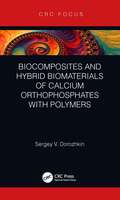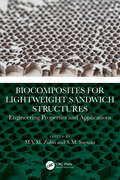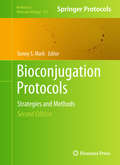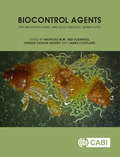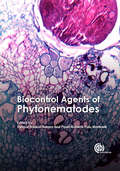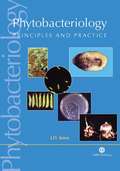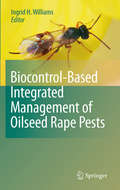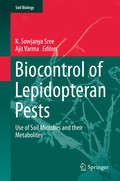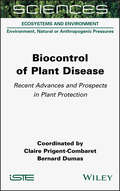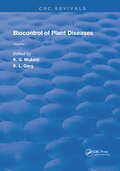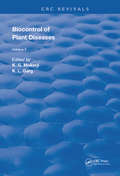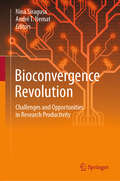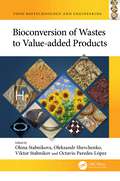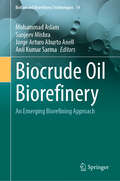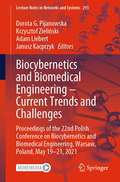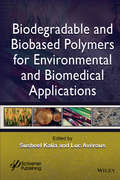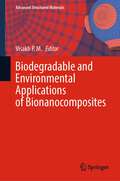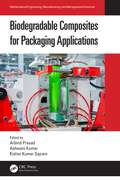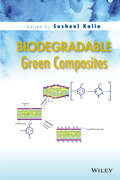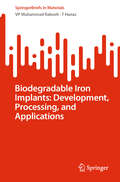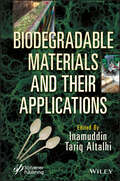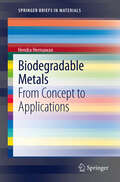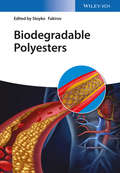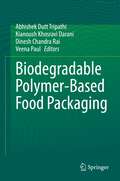- Table View
- List View
Biocomposite Nanomaterials and their Applications (Nanostructure Science and Technology)
by Jayachandran VenkatesanThis contributed book is focused on the use of nanomaterials in biomedical applications, particularly in the development of pharmaceuticals, nutraceuticals, and cosmeceuticals. It covers a wide range of nanomaterials, including polymers, metals, and carbon-based materials, and discusses their incorporation into polymeric biocomposites to create materials with unique properties. The book overviews the various applications of these nanocomposites, including tissue engineering, drug delivery, biosensors, and packaging. It is a useful resource for research scholars, graduate students, academics, and pharmaceutical companies working in the fields of material science and nanotechnology.
Biocomposites and Hybrid Biomaterials of Calcium Orthophosphates with Polymers
by Sergey V. DorozhkinThis title gives an overview of composites and biocomposites. It discusses the history of CaPO4/ /polymer biocomposites and hybrid biomaterials, as well as analyzing the latest developments in the field. It also covers bioactivity and biodegradation of CaPO4-based biomaterials.
Biocomposites for Lightweight Sandwich Structures: Engineering Properties and Applications
by M.Y.M. Zuhri S. M. SapuanBiocomposites for Lightweight Sandwich Structures: Engineering Properties and Applications highlights how the relationship between biocomposites and sandwich structures can provide a unique combination of superior properties that can be optimized for environmentally friendly lightweight applications. It introduces current performance of biocomposites, sandwich structure applications, machining and manufacturing methods, energy-absorbing capabilities, and strengthening techniques of structures, as well as potential, challenges, and future perspectives on performance improvement. Provides latest research on biocomposites and use in lightweight engineering applications. Explores the suitability of core designs using biocomposites and related environmentally friendly materials. Includes recent manufacturing technologies and important performance criteria of sustainable materials for lightweight structures. Discusses existing commercial materials and those that are currently under research and development. This comprehensive reference will be of interest to materials, mechanical, and aerospace engineers and those working in related fields interested in development of materials for lightweight designs.
Bioconjugation Protocols: Strategies and Methods (Methods in Molecular Biology #751)
by Sonny S. MarkContemporary approaches to the synthesis of chemically modified biomacromolecules (proteins, nucleic acids, lipids, and carbohydrates) not only require efficient means to control conjugation and the specific site of attachment of the conjugated moiety but also the effective use of recent developments in the fields of pharmaceutical chemistry, biomolecular/polymer engineering, and nanobiotechnology. In this second edition of Bioconjugation Protocols: Strategies and Methods, expert researchers update the classic methods and introduce valuable new approaches that go beyond basic conjugation techniques to include elements from advanced organic synthesis, molecular biology, surface biotechnology, materials science, and nanobioscience/engineering. These readily reproducible methods cover the preparation of biomolecular conjugates using a variety of labeling techniques and semisynthetic approaches. Additional chapters address the biofunctionalization of surface structures, including organic/inorganic thin films, as well as various types of nanostructures (magnetic nanoparticles, quantum dots, carbon nanotubes, and silicon nanowire devices). All the protocols follow the successful Methods in Molecular BiologyTM series format, each one offering step-by-step laboratory instructions, an introduction outlining the principle behind the technique, lists of the necessary equipment and reagents, and tips on troubleshooting and avoiding known pitfalls. Cutting-edge and highly practical, Bioconjugation Protocols: Strategies and Methods, Second Edition offers both novice and experienced researchers access to the broad array of techniques needed to carry out the semisynthesis of functional biomolecular reagents and/or the biofunctionalization of surfaces and structures of unique interest for a wide variety of applications, ranging from novel biomedical diagnostics to powerful new therapeutics to advanced biomaterials.
Biocontrol Agents
by Mahfouz M.M. Abd-Elgawad Tarique Hassan Askary James CouplandThis book describes entomopathogenic and slug parasitic nematodes as potential biocontrol agents in crop insect and slug pest management. Addressing research on these two nematodes from tropical, subtropical and temperate countries, it covers the new techniques and major developments regarding mass production, formulation, application, commercialization and safety measures. Plans for future strategies to make these beneficial nematodes cost-effective and expand their use by including them in integrated pest management programmes in different agro-ecosystems are also discussed. Biocontrol Agents: Entomopathogenic and Slug Parasitic Nematodes provides a comprehensive review of the topic and is an essential resource for researchers, industry practitioners and advanced students in the fields of biological control and integrated pest management.
Biocontrol Agents of Phytonematodes
by Mahfouz Abd-Elgawad Christian Cumagun M K M K Pedro Luiz Pedro Luiz Martins K K Masanori Masanori Ioannis Ioannis E A E A Fernando Fernando Fábio Fábio Moussa Moussa Uri Uri A H A H C C Anwar Bilgrami Mohammad Reza Mohammad Reza Kamal Kishore ChaudharyPlant-parasitic nematodes are recognized as one of the limiting factors in crop production all over the world. They impair the quality of crops and cause significant yield losses, seriously threatening global food security. Management of these creatures is a vital aspect of the agricultural process and has often depended upon the use of hazardous chemical nematicides, but the disadvantages of these substances have created interest in searching for alternate safe methods of phytonematode management. This book highlights the use of biocontrol agents as a novel, eco-friendly approach in the management of plant-parasitic nematodes. Besides covering the ecology, diversity and geographical distribution, survival biology and virulence mechanisms of potential biocontrol agents, their limitations have also been described. Reviewing biocontrol agents such as nematophafous fungi, parasitic bacteria, predaceous mites, rhizobacteria, mycorrhiza and predaceous nematodes, the book discusses future research needs in detail. Written in a clear and informative style by eminent nematologists from around the world, this book provides a source of valuable information for researchers, teachers, students of plant nematologym enabling them to plan better strategies for managing plant-parasitic nematodes.
Biocontrol Agents of Phytonematodes
by Tarique Hassan Askary Fernando Fernando Moussa Moussa Kamal Kishore Chaudhary A H A H Fábio Fábio Pedro Luiz Pedro Luiz Martins Ioannis Ioannis E A E A Christian Cumagun C C Uri Uri M K M K Mahfouz Mahfouz Mohammad Reza Mohammad Reza Masanori Masanori Anwar Bilgrami P R Martinelli K KHighlighting the use of biocontrol agents as an alternative to chemical pesticides in the management of plant parasitic nematodes, this book reviews the current progress and developments in the field. Tactful and successful exploitation of each biocontrol agent, i.e. nematophagous fungi, parasitic bacteria, predaceous mites, rhizobacteria, mycorrhiza and predaceous nematodes, has been described separately. The contributors are 23 eminent nematologists and their information has been compiled in 19 chapters.
Biocontrol-Based Integrated Management of Oilseed Rape Pests
by Ingrid H. WilliamsOilseed rape is a major arable crop in both Europe and North America. It is attacked by unique complexes of insect pests still largely controlled through the application of chemical insecticides. Crop management systems for the future must combine sustainability with environmental acceptability to satisfy both social and economic demands. This book, in its 17 chapters each led by a world expert, reviews research progress towards developing integrated pest management systems for the crop that enhance conservation biocontrol. This approach is particularly timely because of the development in Europe of insecticide resistance in the pollen beetle, a major pest of the crop. The past decade has seen considerable progress in our knowledge of the parasitoids and predators that contribute to biocontrol, of their distribution patterns, and their behavioural ecology, both within and without the crop. There is potential for natural enemy conservation through modification of within-field crop husbandry practices, as well as, on the landscape scale, through habitat manipulation to encourage vegetational diversity. This book will prove invaluable as a text for researchers, university teachers, graduate scientists, extension workers and growers involved in integrated pest management.
Biocontrol of Lepidopteran Pests: Use of Soil Microbes and their Metabolites (Soil Biology #43)
by Ajit Varma K. Sowjanya SreeThis volume describes the various applications of entomopathogenic soil microorganisms in the management and control of the devastating lepidopteran pest. An introduction describes the insecticidal properties of viruses, bacteria, fungi, nematodes and their metabolites, as well as their applications in the context of crop improvement. Subsequent chapters focus on topics such as insecticidal proteins; the role of nucleopolyhedroviruses; Bt toxins and their receptors; control of lepidopterans using entomopathogenic fungi; management of cotton defoliators; and sustainable use of entomopathogenic nematodes and their bacterial symbionts. An overview of culture collections of entomopathogenic microorganisms rounds out the volume.
Biocontrol of Plant Disease: Recent Advances and Prospects in Plant Protection
by Claire Prigent-Combaret Bernard DumasFaced with climate changes, pest pressure on plants is increasing and new pest complexes are appearing, for which plant protection solutions are not yet available. The reduction of anthropic pressure on agroecosystems requires a reduction in the use of chemical inputs and the promotion of biocontrol approaches. <p><p> In this book, we present new advances on plant disease management that are emerging from research outputs. The ability of biocontrol products to directly (e.g. production of antimicrobial peptides or quorum quenching activities by microorganisms, use of plant or agro-industrial by-products as biopesticides, etc.) or indirectly (e.g. via the increase of plant defense or plant growth pathways) protect plants against pathogens and pests is also considered. <p><p> We also address new strategies like the development of phage-based biocontrol products and those that consider the plant as a holobiont and plant microbiota as targets of biocontrol treatments. The important question of the current regulatory process needed to launch plant production products on the market is also addressed, such as methods to evaluate their environmental impact.
Biocontrol Of Plant Diseases (Routledge Revivals #1)
by K. G. Mukerji K.L. GargFirst Published in 1988, this set offers a comprehensive insight into controlling diseases in plants. Carefully compiled and filled with a vast repertoire of notes, diagrams, and references this book serves as a useful reference for biologists, horticulturalists, other practitioners in their respective fields.
Biocontrol Of Plant Diseases (Routledge Revivals #2)
by K. G. Mukerji K.L. GargFirst Published in 1988, this set offers a comprehensive insight into controlling diseases in plants. Carefully compiled and filled with a vast repertoire of notes, diagrams, and references this book serves as a useful reference for biologists, horticulturalists, other practitioners in their respective fields.
Bioconvergence Revolution: Challenges and Opportunities in Research Productivity
by Nina Siragusa André T. NematThis book offers a comprehensive overview of how to utilize the bioconvergence revolution to substantially enhance research productivity. It carefully addresses critical issues such as ethical dilemmas, collaborative dynamics, funding, and operational efficiency, complete with concrete examples of how to overcome these challenges. Historically, the natural world has served as a profound source of inspiration for technological innovation. The natural materials, structures, and processes found in organisms have facilitated numerous scientific advancements. Presently, the integration of nature with scientific research is intensified through convergence. The book explores this convergence as a multidisciplinary approach that leverages the synergies among digital technologies, material sciences, and biotechnology, aiming to significantly accelerate and broaden the scope of scientific breakthroughs. This volume provides a scholarly account of the emerging opportunities catalyzed by bioconvergence, emphasizing the necessity for rigorous ethical frameworks and standards as biotechnologies and digital tools converge to explore new frontiers. It delves into the challenges of financing scientific advancement and articulates how funding underpins multidisciplinary research efforts. Featuring Israel as a leader in this revolutionary field, the book meticulously outlines the Israeli ecosystem as a paradigm of innovation in bioconvergence. This work possesses a broad interdisciplinary appeal, making it an essential resource for researchers in both industry and academia, as well as for scholars and funding bodies dedicated to the advancement of science.
Bioconversion of Wastes to Value-added Products (Food Biotechnology and Engineering)
by Olena Stabnikova Oleksandr Shevchenko Viktor Stabnikov Octavio Paredes-LópezBioconversion of agricultural and industrial wastes into useful products plays an important role both in the economy and in the prevention of environmental pollution. This book presents technological approaches to the biotransformation of different wastes into valuable products and demonstrates developments in the field of organic waste disposal. Organized in four parts, Bioconversion of Wastes to Value-added Products addresses the bioconversion of wastes to (a) new food products, (b) energy; (c) biotechnological products, and (d) describes the construction of biosensors for food control. Features: • Covers the use of different food waste to enrich meat, dairy, bakery, and confectionery products • Presents new technologies for utilization of wastes from the meat, dairy, and wine industries, among others • Promotes bioconversion of agricultural wastes into energy such as hydrogen or biogas • Proposes the use of industrial wastes to produce exopolysaccharides using bacteria or macromycetes • Describes design, construction and testing of biosensors for food control The book is an aid to scientists and engineers contributing to manufacturing of useful products from non-recyclable wastes, as well as the creation of environmentally friendly technologies that protect the environment from potential contaminants.
Biocrude Oil Biorefinery: An Emerging Biorefining Approach (Biofuel and Biorefinery Technologies #14)
by Mohammad Aslam Sanjeev Mishra Jorge Arturo Aburto Anell Anil Kumar SarmaBiorefineries are increasingly important in providing sustainable routes to the oil industry. This book provides a comprehensive analysis of biocrude biorefinery to convert biocrude into environmentally friendly fuels and high-value-added products.It begins by discussing the biorefinery concept with its fundamentals and biocrude biorefinery as a sustainable solution for bioenergy and the green economy, explaining the chemistry and reaction mechanism behind biocrude production and analysing the different feedstocks, including lignocellulosic biomass, for biocrude production, recent developments and associated challenges.The second part focuses on waste oils and liquid wastes for sustainable biocrude oil production in a biorefinery approach, as well as on 3rd generation of biorefinery feedstocks (algal biomass) as emerging feedstock for biocrude oil production and high-value products in biorefineries and biocrude oil derived from municipal and industrial organic wastes in the framework of a waste biorefinery concept. Furthermore, bio-oil constitutes a promising energy source for future hydrogen production as well as for the catalytic conversion of crude bio-oil into environmentally friendly transport fuels. The physicochemical and analytical techniques used for the analysis of crude bio-oil with fuel properties and international standards, as well as microbial production and its future applications are also covered.This book will be of great interest to practitioners, graduate students, researchers and policymakers involved in crude bio-oil biorefineries for sustainable development. This book also explores the relationship between biofuels and Sustainable Development Goals (SDGs) 7. Furthermore, the book lays a solid foundation for the establishment of crude bio-oil-based biorefineries and thus contributes to a sustainable, cleaner, greener and livable blue planet for the next generations. Crude bio-oil is likely to be the "green gold" of the biorefinery of the future and this book will be a milestone for biorefineries.
Biocybernetics and Biomedical Engineering – Current Trends and Challenges: Proceedings of the 22nd Polish Conference on Biocybernetics and Biomedical Engineering, Warsaw, Poland, May 19-21, 2021 (Lecture Notes in Networks and Systems #293)
by Dorota G. Pijanowska Krzysztof Zieliński Adam Liebert Janusz KacprzykThis book contains 13 chapters in which you can find various examples of the development of methods and/or systems supporting medical diagnostics and therapy, related to biomedical imaging, signal and image processing, biomechanics, biomaterials and artificial organs, modeling of biomedical systems, which, as the current research issues, were presented at the 22nd Polish BBE Conference held at the Nalecz Institute of Biocybernetics and Biomedical Engineering, Polish Academy of Sciences, in May 2021. Obviously, it is not easy to recommend an interdisciplinary book as it may seem inconsistent in some respects. This is the case here because it concerns the area of biocybernetics and biomedical engineering (BBE), which is not only an interdisciplinary but even multidisciplinary science. On the other hand, the scattered subject matter of the book is its advantage, as the book may be of interest to an advanced and wide range of readers and researchers representing both medical, biological and technical points of view.
Biodegradable and Biobased Polymers for Environmental and Biomedical Applications
by Susheel Kalia Luc AvérousThis volume incorporates 13 contributions from renowned experts from the relevant research fields that are related biodegradable and biobased polymers and their environmental and biomedical applications. Specifically, the book highlights: Developments in polyhydroxyalkanoates applications in agriculture, biodegradable packaging material and biomedical field like drug delivery systems, implants, tissue engineering and scaffolds The synthesis and elaboration of cellulose microfibrils from sisal fibres for high performance engineering applications in various sectors such as the automotive and aerospace industries, or for building and construction The different classes and chemical modifications of tannins Electro-activity and applications of Jatropha latex and seed The synthesis, properties and applications of poly(lactic acid) The synthesis, processing and properties of poly(butylene succinate), its copolymers, composites and nanocomposites The different routes for preparation polymers from vegetable oil and the effects of reinforcement and nano-reinforcement on the physical properties of such biobased polymers The different types of modified drug delivery systems together with the concept of the drug delivery matrix for controlled release of drugs and for antitumor drugs The use of nanocellulose as sustainable adsorbents for the removal of water pollutants mainly heavy metal ions, organic molecules, dyes, oil and CO2 The main extraction techniques, structure, properties and different chemical modifications of lignins Proteins and nucleic acids based biopolymers The role of tamarind seed polysaccharide-based multiple-unit systems in sustained drug release
Biodegradable and Environmental Applications of Bionanocomposites (Advanced Structured Materials #177)
by Visakh P. M.This book provides cutting-edge, up-to-date research findings on the use of bionanocomposites in biodegradable and environmental applications, while also detailing how to achieve bionanocomposites preparation, characteristics, and significant enhancements in physical, chemical, mechanical, thermal properties and applications. This book on biodegradable and environmental properties of bionanocomposites provides a comprehensive and updated review of major innovations in the field of polymer-based bionanocomposites for biodegradable and environmental applications. It covers properties and applications, including the synthesis of polymer-based bionanocomposites from different sources biomaterials-based composites and tactics on the efficacy and major challenges associated with successful scale-up fabrication on bionanocomposites.It is an essential reference for future research in bionanocomposites as topics such as sustainable, biodegradable, and environmental methods for highly innovative and applied materials are current topics of importance. The book covers a wide range of research on bionanocomposite and their biodegradable and environmental applications. Updates on the most relevant polymer-based bionanocomposite and their prodigious potential in the fields of biodegradable and the environment are presented. Leading researchers from industry, academy, government, and private research institutions across the globe contribute to this book. Scientists, engineers, and students with interest in the most important advancements in the field of bionanocomposites involving high-performance bionanocomposites will benefit from this book which is highly application-oriented.
Biodegradable Composites for Packaging Applications (Mathematical Engineering, Manufacturing, and Management Sciences)
by Prasad Arbind"Biodegradable Composites for Packaging Applications" describes design, processing, and manufacturing of advanced biodegradable composites in packaging industry applications. It covers fundamentals of biodegradable polymers followed by introduction to biodegradable materials for food packaging industry and its processing mechanisms. Pertinent applications are explained across different chapters including intelligent packaging, applied technologies, degradation problems and its impact on environment and associated challenges. Features Covers biodegradable composites and targeted applications in packaging for industrial applications. Includes exhaustive processing and characterizations of biodegradable composites. Discusses innovative commodities packaging applications. Reviews advanced integrated design and fabrication problems for conductive and sensors applications. Explores various properties and functionalities through extensive theoretical and experimental modeling. This volume is aimed at researchers and graduate students in sustainable materials, composite technology, biodegradable plastics, and food technology and engineering.
Biodegradable Green Composites
by Susheel KaliaThis book comprehensively addresses surface modification of natural fibers to make them more effective, cost-efficient, and environmentally friendly. Topics include the elucidation of important aspects surrounding chemical and green approaches for the surface modification of natural fibers, the use of recycled waste, properties of biodegradable polyesters, methods such as electrospinning, and applications of hybrid composite materials.
Biodegradable Iron Implants: Development, Processing, and Applications (SpringerBriefs in Materials)
by VP Muhammad Rabeeh T HanasThis book offers a comprehensive guide to iron-based biodegradable metals (BMs) for temporary implant applications, addressing the need for medical implants that can safely degrade within the human body, thereby eliminating the necessity for additional surgeries and reducing long-term complications. Beginning with an introductory overview of BMs, it explains their significance in modern medicine and outlines the essential requirements for these materials and a comparative analysis of magnesium, zinc, and iron-based alloys. This chapter lays the foundation for understanding BMs' role in advancing healthcare solutions. The second chapter focuses on the interaction between iron and the human body, detailing iron's degradation and mechanical characteristics in the physiological environment. It explains the potential degradation routes of iron both in vitro and in vivo, while discussing the advantages and limitations of iron as a BM for temporary implants, supported by references to relevant literature. The third Chapter looks at recent advancements in manufacturing techniques aimed at improving the effectiveness and safety of iron-based implants. It emphasizes material fabrication and explores various manufacturing routes, including powder metallurgy, casting, and additive manufacturing. The performance of components made through different methods in the physiological environment is also examined. In Chapter four, the book covers various metallurgical and surface modification techniques such as alloying, surface treatments, and composite fabrication. It highlights the importance of post-processing developed materials to enhance the properties of iron implants, ensuring controlled degradation and maintaining mechanical strength during the healing process. This chapter provides valuable insights into how to process and customize the characteristics of iron to meet specific medical needs, particularly in cardiovascular and orthopedic medicine. The fifth chapter explores the potential applications of iron-based BMs in various medical fields. It discusses possible uses in cardiovascular, orthopedic, and other medical applications, based on reported literature. The final chapter provide a Summary & Future Prospective of Fe based degradable implants. Overall, this book is targeted at individuals in the fields of biomedical engineering, materials science, and medical practice who are engaged in the development and utilization of medical implants. It aims to significantly advance ongoing efforts by shedding light on novel materials and manufacturing techniques in medical technology.
Biodegradable Materials and Their Applications
by Inamuddin Tariq A. AltalhiBIODEGRADABLE MATERIALS AND THEIR APPLICATIONS Biodegradable materials have ascended in importance in recent years and this book comprehensively discusses all facets and applications in 29 chapters making it a one-stop shop. Biodegradable materials have today become more compulsory because of increased environmental concerns and the growing demand for polymeric and plastic materials. Despite our sincere efforts to recycle used plastic materials, they ultimately tend to enter the oceans, which has led to grave pollution. It is necessary, therefore, to ensure that these wastes do not produce any hazards in the future. This has made an urgency to replace the synthetic material with green material in almost all possible areas of application. Biodegradable Materials and Their Applications covers a wide range of subjects and approaches, starting with an introduction to biodegradable material applications. Chapters focus on the development of various types of biodegradable materials with their applications in electronics, medicine, packaging, thermoelectric generations, protective equipment, films/coatings, 3D printing, disposable bioplastics, agriculture, and other commercial sectors. In biomedical applications, their use in the advancement of therapeutic devices like temporary implants, tissue engineering, and drug delivery vehicles are summarized. Audience Materials scientists, environmental and sustainability engineers, and any other researchers and graduate students associated with biodegradable materials.
Biodegradable Metals: From Concept to Applications (SpringerBriefs in Materials)
by Hendra HermawanThis book in the emerging research field of biomaterials covers biodegradable metals for biomedical applications. The book contains two main parts where each of them consists of three chapters. The first part introduces the readers to the field of metallic biomaterials, exposes the state of the art of biodegradable metals, and reveals its application for cardiovascular implants. Some fundamental aspects to give basic understanding on metals for further review on the degradable ones is covered in chapter one. The second chapter introduces the concept of biodegradable metals, it's state of the art and discuses a shifted paradigm from inert to bioactive, from corrosion resistant to corrodible metals. The third chapter focuses on the challenges and opportunities of using biodegradable metals for cardiovascular applications. The second part exposes an example of biodegradable metals from its concept to applications where a complete study on metallic biodegradable stent is detailed from materials design, development, testing till the implant fabrication. The forth chapter reveals new alloys development devoted for metallic biodegradable stent based on required criteria derrived from clinical needs and current nondegradable stents properties. Degradation of the alloys in simulated arterial conditions and its effect to cells are exposed in chapter five. The both chapters are concluded with a benchmarking of some more recent researches on materials development and testing for biodegradable stents. Chapter six reveals the tranformation process of the materials into stent prototypes where a standard process for making 316L stainless steel stents was followed. The book is completed by a perspective on the use of biodegradable metals for biomedical applications in the era of tissue engineering.
Biodegradable Polyesters
by Stoyko FakirovCollating otherwise hard-to-get and recently acquired knowledge in one work, this is a comprehensive reference on the synthesis, properties, characterization, and applications of this eco-friendly class of plastics. A group of internationally renowned researchers offer their first-hand experience and knowledge, dealing exclusively with those biodegradable polyesters that have become increasingly important over the past two decades due to environmental concerns on the one hand and newly-devised applications in the biomedical field on the other. The result is an unparalleled overview for the industrial chemist and materials scientist, as well as for developers and researchers in industry and academia alike.
Biodegradable Polymer-Based Food Packaging
by Abhishek Dutt Tripathi Kianoush Khosravi Darani Dinesh Chandra Rai Veena PaulThis book covers different aspects of biodegradable packaging, such as their sourcing and application in food industries. The book focuses on the production and characterization of biodegradable food packaging derived from plant, animal and microbial sources. Chapters highlight the nano-technological interventions in biodegradable food packaging and the less studied microbial biopolymer-based biodegradable food packaging makes it distinct from other related books. It includes the latest research and development in the areas of food processing, food packaging, material science and polymeric science. It also discusses the standards and regulatory guidelines about the biodegradability testing of these polymers.This book is meant for researchers in food science, food packaging, bioprocess technology, polymer science and biochemical engineering. It is also beneficial for faculty members and students of food microbiology, food technology, dairy technology. The book is also meant for small entrepreneurs and farmers who are interested in bio-plastic usage for food packaging.

